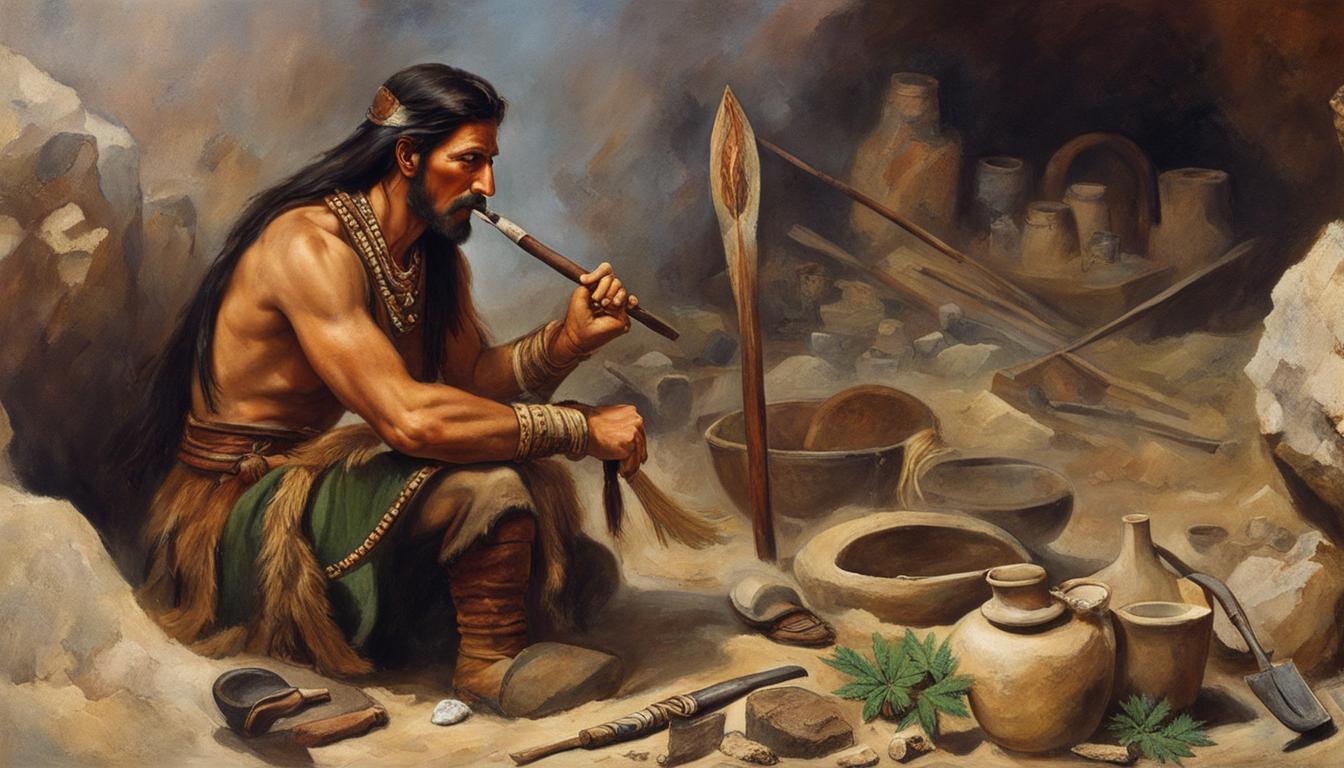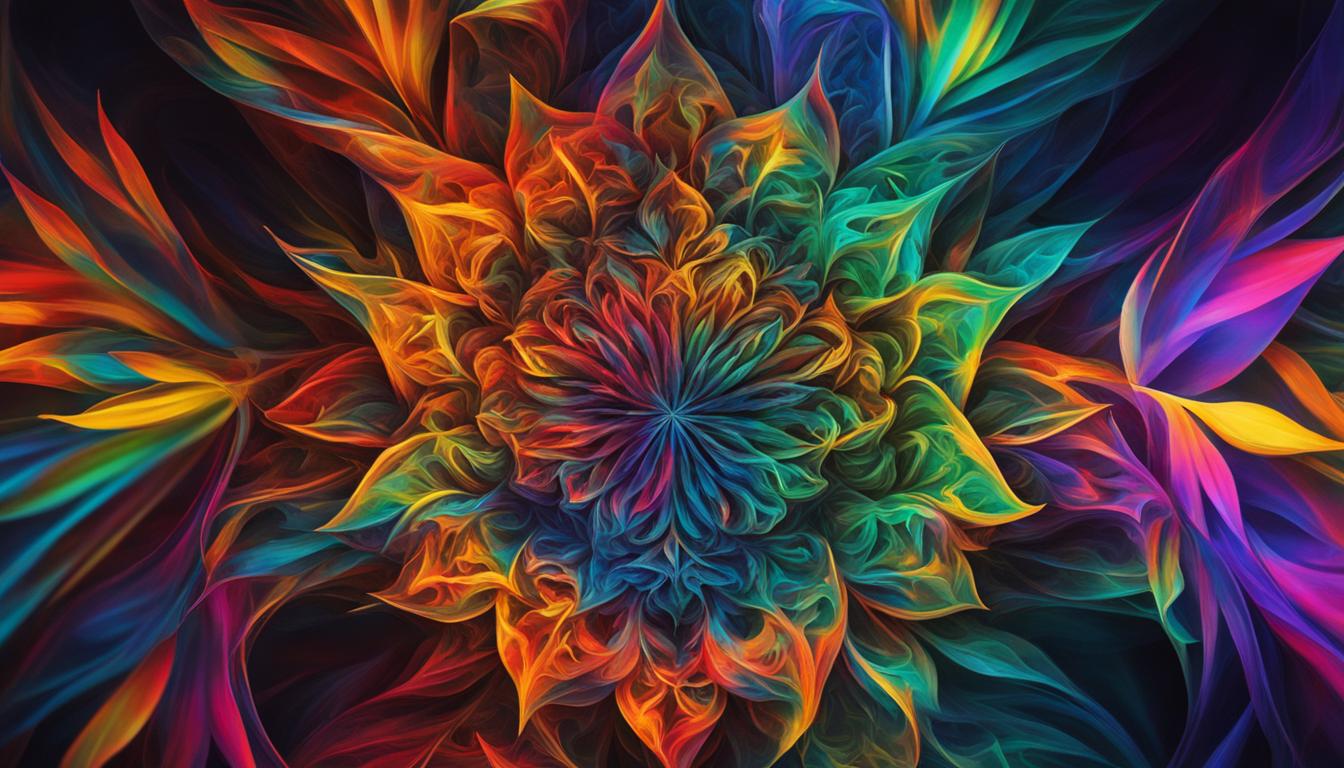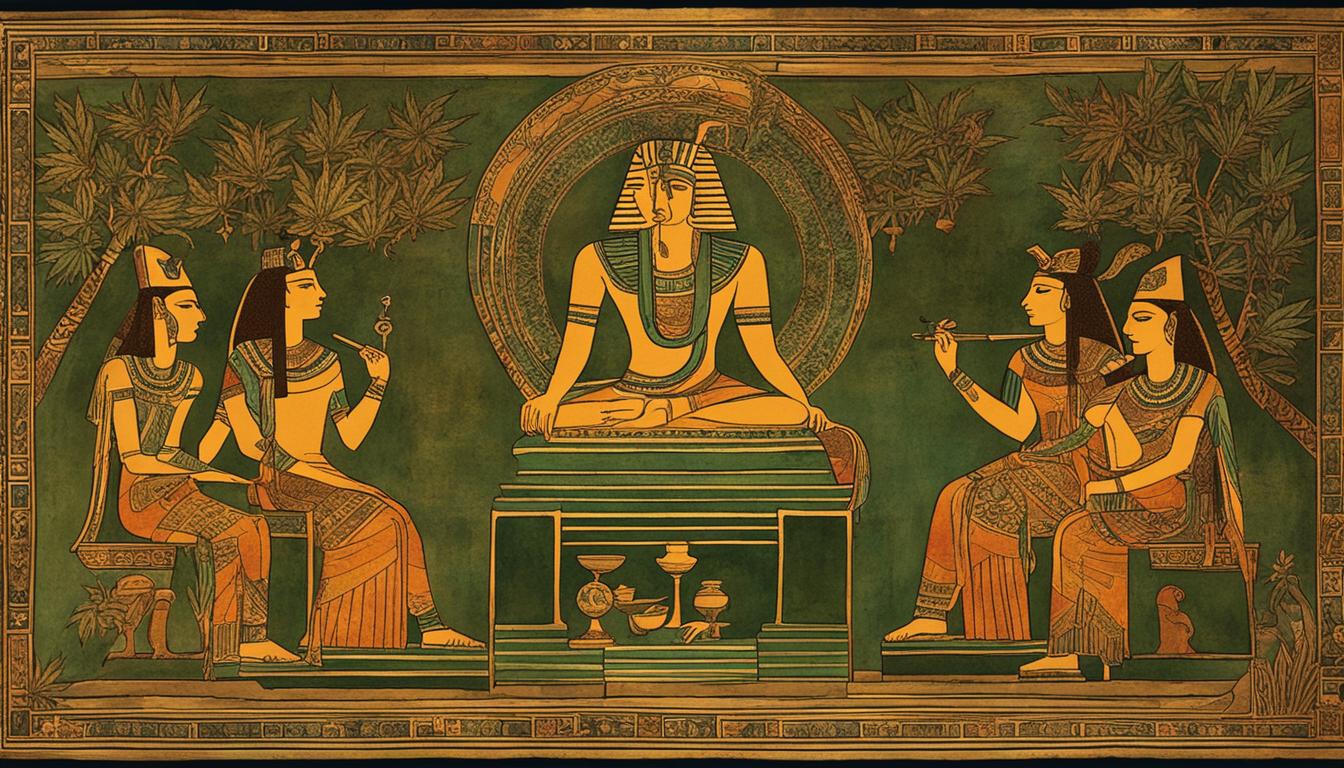The Scythians and Their Use of Cannabis
Welcome to the fascinating world of Scythian Cannabis Archaeology, where we uncover the ancient secrets of cannabis usage and explore the historical cannabis artifacts left behind by the Scythian nomadic people. Journey with us as we delve into the rich cultural heritage of the Scythians and discover the significance of cannabis in their daily lives.
From the earliest traces of ancient cannabis usage to the remarkable discoveries of archaeological evidence, we will unravel the mysteries surrounding the Scythians’ relationship with this sacred plant. Prepare to be inspired as we explore the profound impact of Scythian cannabis archaeology on our understanding of human civilization.
The History of Bongs: From Africa to Asia
The use of bongs, also known as water pipes, for smoking cannabis has a long and fascinating history. While it was previously believed that bongs originated in Africa in the 1100s, recent archaeological discoveries have revealed an even earlier timeline. In 2013, two ornate gold bongs dating back to 400BC were unearthed in a Scythian burial mound in southern Russia, providing evidence of cannabis use by the Scythians long before it was known in other parts of the world.
The discovery of these ancient artifacts challenges the prevailing narrative surrounding the origins of bongs and highlights the prominence of cannabis in Scythian culture. The intricate design and craftsmanship of these gold bongs suggest a deep reverence for cannabis and its role in the spiritual and social lives of the Scythians. These findings have expanded our understanding of the ancient and global significance of cannabis use.
It is important to note that the use of bongs for smoking cannabis did not remain confined to the Scythians alone. As cannabis and its associated rituals spread across different regions, the design and materials used to create bongs evolved accordingly. While anything from an apple to a milk jug can be used to fashion a makeshift bong, modern bongs are typically made from glass, acrylic, or plastic. The use of water in bongs serves to cool and filter the smoke, resulting in a smoother and more enjoyable smoking experience.
| Timeline | Region | Bong Materials |
|---|---|---|
| 400BC | Southern Russia (Scythia) | Gold |
| 1100s | Africa | Bamboo and pottery |
| 14th century | Thailand | Bamboo |
| 20th century | North America | Glass, acrylic, and plastic |
The Scythian Relationship with Cannabis
According to the Greek historian Herodotus, the Scythians had a strong affinity for cannabis, incorporating it into various aspects of their culture. Both men and women regularly consumed cannabis for pleasure and relaxation, utilizing its psychoactive properties to connect with the spirit world. This ancient nomadic people valued the plant for its ability to induce a state of euphoria and provide a respite from the challenges of their nomadic lifestyle.
The significance of cannabis in Scythian culture is further supported by the discovery of cannabis residue in Scythian burial mounds. Archaeological findings have unveiled remnants of cannabis in burial artifacts, suggesting that the plant played a crucial role in their rituals and ceremonies. These ancient discoveries offer a glimpse into the deep-rooted relationship between the Scythians and cannabis, highlighting the plant’s integral place in their society.
“The Scythians, between drinking and sleeping, anoint the stones with cannabis and enjoy the vapor that comes from it, which intoxicates them to such an extent that they shout for joy.” – Herodotus
The use of cannabis was not limited to specific rituals or events but was woven into the fabric of everyday life for the Scythians. It served as a means of relaxation, allowing them to find solace and enjoyment amidst the challenges of their nomadic existence. The Scythians’ profound connection with cannabis is a testament to the enduring allure and cultural significance of this ancient plant.

| Key Points | Details |
|---|---|
| Scythian Cannabis Consumption | Both men and women regularly consumed cannabis for pleasure and relaxation. |
| Archaeological Evidence | Discovery of cannabis residue in Scythian burial mounds confirms the plant’s significance in their rituals and ceremonies. |
| Everyday Use | Cannabis played a role in everyday life, providing relaxation and enjoyment for the Scythians. |
The Evolution of Bong Design
The evolution of bong design has been a fascinating journey, with advancements in manufacturing techniques and materials leading to innovative and visually stunning creations. From simple homemade versions to intricate works of art, bongs have come a long way in both form and function.
While anything can be used to make a bong, modern designs typically feature glass, acrylic, or plastic materials. These materials are not only durable but also allow for intricate details and unique shapes. Bongs can now be found in various sizes, ranging from discreet handheld options to large, multi-chambered pieces.
The use of water in bongs has also played a significant role in their evolution. By passing the smoke through water, bongs help to cool and filter it, resulting in a smoother and more enjoyable smoking experience. Some bongs even incorporate additional filtration systems, such as percolators, to further enhance the quality of smoke.
The Advancements in Manufacturing and Design
The advancements in manufacturing techniques have paved the way for bongs with intricate designs and functional features. CNC machining and 3D printing have made it possible to create complex shapes and patterns, pushing the boundaries of what is possible in bong design.
| Advancements in Bong Design | Benefits |
|---|---|
| Multiple chambers | Improved smoke filtration |
| Percolators | Enhanced smoke diffusion |
| Ice catchers | Additional cooling of smoke |
| Unique shapes and designs | Personalized aesthetics |
“Bong design has evolved tremendously over the years, with manufacturers pushing the boundaries of creativity and functionality. The use of advanced manufacturing techniques has allowed for the creation of bongs with intricate details and improved smoking experiences.” – Bong Enthusiast
As the demand for bongs continues to grow, manufacturers are constantly pushing the boundaries of design and innovation. From novel materials to groundbreaking filtration systems, the future of bong design looks bright. Whether you are a connoisseur or a casual user, there is undoubtedly a bong out there that will suit your style and elevate your smoking experience.
The Spread of Cannabis and Bongs
The Scythians, an ancient nomadic people, played a significant role in spreading the use of cannabis throughout different regions. They brought cannabis to Greece, where it became known as “kannabis” and was used for its medicinal and psychoactive properties. Arabic scholars believe that cannabis was introduced to the Levant countries by Mongol invaders, further expanding its presence in the Middle East and North Africa. The English word “bong” is derived from the Thai word “baung,” which dates back to the 14th century. This indicates the global influence of the Scythians in the dissemination of cannabis and the concept of using water pipes or bongs for smoking.
It was not until the 1960s and 70s that the use of bongs spread to North America. This can be attributed in part to soldiers returning from the Vietnam War, who brought back their experiences and the use of bongs as a method of consuming cannabis. The popularity of bongs continues to grow worldwide, with various designs and materials being used to enhance the smoking experience.
| Region | Period | Significance |
|---|---|---|
| Greece | Ancient times | Introduction of cannabis |
| Middle East and North Africa | Medieval period | Mongol invaders introduce cannabis |
| Thailand | 14th century | Origin of the word “bong” |
| North America | 1960s and 70s | Spread of bong usage |
Through their nomadic lifestyle and interactions with different cultures, the Scythians played a vital role in the dissemination of cannabis and the use of bongs. The research and exploration of the Scythian culture and artifacts continue to provide valuable insights into the ancient origins and cultural significance of cannabis. By studying their legacy, we gain a deeper understanding of the role cannabis has played in shaping ancient civilizations.
Uncovering the Scythian Gold Bongs
In 2013, a team of archaeologists made an extraordinary discovery in southern Russia: two solid gold bongs dating back to 400BC. These magnificent artifacts, weighing nearly seven pounds each, offer a glimpse into the opulent lifestyle of the ancient Scythians and their close relationship with cannabis. The discovery of these 2400-year-old bongs sheds light on the elaborate rituals and practices of this enigmatic nomadic people.
The Scythians, known for their skilled horsemanship and fierce warrior culture, had a deep reverence for cannabis. They used these gold bongs as a means to consume not only cannabis but also opium, as evidenced by the residue found inside. These sacred objects were likely used in ceremonial rituals and gatherings, where the Scythians sought to connect with the spirit world and commune with their ancestors.
The ornate designs and exquisite craftsmanship of the Scythian gold bongs reflect the cultural and artistic sophistication of this ancient civilization. Each bong is adorned with intricate patterns and mythical creatures, showcasing the Scythians’ reverence for beauty and symbolism. These artifacts not only serve as a testament to their mastery of metalwork but also provide valuable insights into the Scythian worldview and their beliefs surrounding cannabis.
| Scythian Gold Bongs | Description |
|---|---|
| Material | Solid gold |
| Date | 400BC |
| Weight | Nearly seven pounds each |
| Function | Used for consuming cannabis and opium |
| Decorations | Intricate patterns and mythical creatures |

“These Scythian gold bongs represent the peak of craftsmanship and artistic expression in ancient times. The level of detail and intricacy is unmatched, and they provide a window into the Scythian culture and their deep reverence for both cannabis and opium.” – Dr. Alexander Ivanov, Lead Archaeologist
The Symbolism of Scythian Gold Artifacts
The ornate gold vessels discovered in Scythian burial mounds are not only visually stunning but also rich with symbolism. They provide valuable insights into the culture and beliefs of the ancient Scythians. One vessel, depicting an old man slaying young warriors, suggests the Scythians’ prowess in battle and their dominance over their enemies. This imagery serves as a testament to the warrior culture of the Scythians and their dedication to martial prowess.
The other vessel showcases intricate depictions of mythological creatures, possibly representing the Scythian underworld. This suggests a belief in the supernatural and a connection between the living and the spirit world. The attention to detail in these depictions, including the clothing and weaponry worn by the figures, offers a glimpse into the Scythian lifestyle and the importance they placed on their traditions and beliefs.
“The imagery on the Scythian gold vessels provides valuable insights into the culture and beliefs of the ancient Scythians.”
It is important to note that the symbolism on the gold vessels may not be immediately apparent to modern viewers. The Scythians lived in a different time and had their own unique worldview. Interpreting the intricate symbols and designs requires a deep understanding of their cultural context and rituals. However, the discovery of these artifacts allows us to glimpse into the ancient Scythian culture and appreciate the artistry and symbolism that was important to them.
In conclusion, the symbolism found on the Scythian gold vessels provides valuable insights into the ancient Scythian culture, its beliefs, and its connection to the supernatural. These artifacts not only showcase the artistic skill of the Scythians but also reflect their customs and traditions. As we continue to study and analyze these ancient relics, we deepen our appreciation for the rich and complex history of the Scythians and their enduring legacy.
The Significance of Scythian Cannabis Use
Scythian rituals were intrinsically tied to the use of cannabis, which played a significant role in their daily lives. Cannabis provided a means for the Scythians to find pleasure and relaxation amidst the challenges of their nomadic lifestyle. It served as a gateway to the spirit world, allowing them to commune with their ancestors and establish a deeper connection with the divine.
The Scythians, both men and women, regularly consumed cannabis for its euphoric effects. It offered a respite from the harsh realities of their existence and provided a sense of serenity and calm. Through the use of cannabis, the Scythians were able to transcend the physical limitations of their nomadic lifestyle and tap into a higher state of consciousness, allowing them to explore the realms of the spiritual.
“Cannabis was held in high regard among the Scythians, who believed it to be a sacred plant with mystical properties. Its role in their rituals was paramount, acting as a conduit between the mortal and divine realms.”
The discovery of cannabis residue in Scythian burial mounds further emphasizes the cultural significance of cannabis for the Scythians. It not only played a role in their rituals, but also held importance in their burial practices, symbolizing the journey to the afterlife. The presence of cannabis artifacts in these burial sites serves as a testament to the enduring legacy of the Scythians’ cannabis use and its integral role in their culture.
The Rituals of Scythian Cannabis Consumption
Scythian cannabis rituals were elaborate and sacred, involving the use of specially designed bongs and other smoking apparatus. These intricate devices, such as the exquisite gold bongs discovered in Southern Russia, were not only utilitarian but also symbols of status and wealth within the Scythian society.
The act of consuming cannabis was a communal experience for the Scythians, often taking place during gatherings and celebrations. The smoke produced by burning cannabis was believed to carry messages from the divine realm, connecting the participants with the spiritual energies surrounding them. This shared experience fostered a sense of unity and belonging among the Scythian people, reinforcing their cultural identity and strengthening their bond as a community.
| Ritual | Description |
|---|---|
| Burial Rites | Included the placement of cannabis artifacts in burial mounds, symbolizing the journey to the afterlife and the spiritual connection with ancestors. |
| Community Gatherings | Cannabis consumption during celebrations and gatherings served as a means of communal bonding and spiritual exploration. |
| Divination | Scythians believed that cannabis allowed them to receive messages from the divine realm, assisting in the interpretation of signs and omens. |
The Scythians’ use of cannabis in their rituals and daily life holds great significance in understanding their culture and spirituality. These ancient practices provide valuable insights into the Scythian way of life and the profound impact that cannabis had on their worldview and social dynamics.
The Legacy of Scythian Cannabis Archaeology
The archaeological discoveries of Scythian cannabis artifacts have unveiled a fascinating window into the historical significance of cannabis use and its rich cultural heritage. These artifacts, ranging from ornate gold bongs to cannabis residue found in burial mounds, offer valuable insights into the ancient origins and widespread use of cannabis among the Scythians and beyond.
The Scythians’ cultural legacy is intimately intertwined with cannabis, as evidenced by their elaborate rituals and the symbolism depicted on their gold vessels. These artifacts showcase the Scythians’ deep connection to cannabis, which played a significant role in their daily life and served as a means of finding pleasure, relaxation, and spiritual communion.
Today, the study of Scythian cannabis archaeology continues to illuminate the historical, social, and medicinal significance of this ancient plant. By examining the artifacts left behind by the Scythians, we gain a deeper understanding of their culture and its impact on the spread of cannabis throughout ancient civilizations.
Future Implications and Research
The exploration of Scythian cannabis archaeology has far-reaching implications for our understanding of ancient civilizations and their practices. The significance of cannabis use in these cultures sheds light on the enduring relationship between humans and this remarkable plant. As we uncover more about the Scythians and their use of cannabis, we are sure to gain further insights into the profound impact it had on their society and the wider ancient world.
| Table 1 – Scythian Cannabis Artefacts |
|---|
| Ornate gold bongs dating back to 400BC |
| Cannabis residue in Scythian burial mounds |
| Depictive imagery on gold vessels |
Conclusion
The Scythians’ research into cannabis has revealed fascinating discoveries about the ancient usage of this plant. Through archaeological excavations, we have uncovered ancient cannabis artifacts that provide valuable insights into the history of cannabis use and its cultural significance. The Scythians played a crucial role in spreading the use of cannabis across different regions, leaving a lasting impact on ancient civilizations.
The study of Scythian cannabis research not only deepens our understanding of ancient cultures but also sheds light on the medicinal, social, and spiritual aspects of cannabis. From their use of cannabis in rituals to find pleasure and relaxation to its role in connecting with the spirit world, the Scythians’ relationship with this ancient plant is undeniable.
Through their intricate gold bongs, the Scythians left behind a tangible legacy that showcases their cultural heritage. These artifacts, with their rich symbolism and detailed depictions, provide a glimpse into the Scythian lifestyle and traditions. They stand as a testament to the enduring significance of cannabis and its profound impact on human civilization.
As we continue to unearth more about the Scythians and their ancient cannabis discoveries, our knowledge of ancient civilizations is enriched. The research and exploration of Scythian cannabis archaeology offer endless possibilities for unraveling the mysteries of the past and understanding the profound influence of this remarkable plant throughout history.
FAQ
What is the significance of the Scythians’ use of cannabis?
The Scythians’ use of cannabis was significant as it played a role in their rituals, daily life, and connection with the spirit world. It allowed them to find pleasure and relaxation amidst their nomadic lifestyle.
How were bongs used for smoking cannabis?
Bongs, also known as water pipes, have been used for smoking cannabis for thousands of years. The use of water in bongs helps to cool and filter the smoke, providing a smoother smoking experience.
How did the Scythians spread the use of cannabis?
The Scythians played a significant role in spreading the use of cannabis throughout Europe, the Middle East, and North Africa. They brought cannabis to Greece, and Arabic scholars believe it was introduced to the Levant countries by Mongol invaders.
What materials are modern bongs typically made from?
Modern bongs are typically made from glass, acrylic, or plastic. However, anything can be used to make a bong, from an apple to a milk jug.
What were the recent archaeological discoveries relating to Scythian cannabis use?
In 2013, two ornate gold bongs dating back to 400BC were discovered in a Scythian burial mound in southern Russia. These artifacts provide evidence of cannabis use by the Scythians long before it was known in other parts of the world.
What can the Scythian gold vessels tell us about their culture?
The Scythian gold vessels are rich with symbolism and provide valuable insights into the Scythian culture and lifestyle. The detailed depictions of clothing and weaponry on these artifacts offer clues about their war exploits and representation of the Scythian underworld.
How did the Scythians use cannabis in their rituals?
According to the Greek historian Herodotus, the Scythians used cannabis as a way to connect with the spirit world. It is believed that both men and women regularly consumed cannabis for pleasure and relaxation.
What is the significance of Scythian cannabis artifacts?
The archaeological discoveries of Scythian cannabis artifacts provide valuable insights into the history of cannabis use and its cultural significance. These artifacts serve as a testament to the enduring legacy of the Scythian people and their impact on the spread of cannabis throughout ancient civilizations.
How did bongs evolve over time?
Bongs have evolved over time, with advancements in manufacturing leading to more ornate designs and multiple chambers. Their origins can be traced back to the Scythians, who used gold bongs for smoking cannabis thousands of years ago.
What is the significance of Scythian cannabis archaeology?
The study of Scythian cannabis archaeology continues to shed light on the ancient origins of cannabis use and its influence on human culture. It provides valuable insights into the cultural, social, and medicinal significance of this ancient plant.














